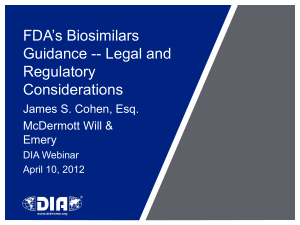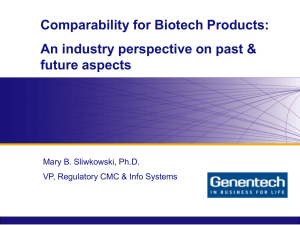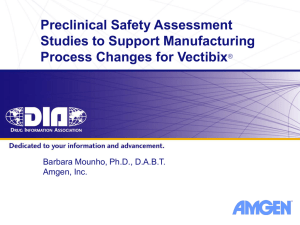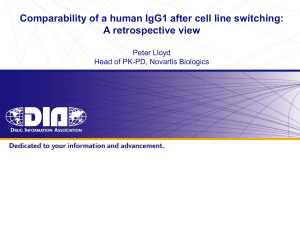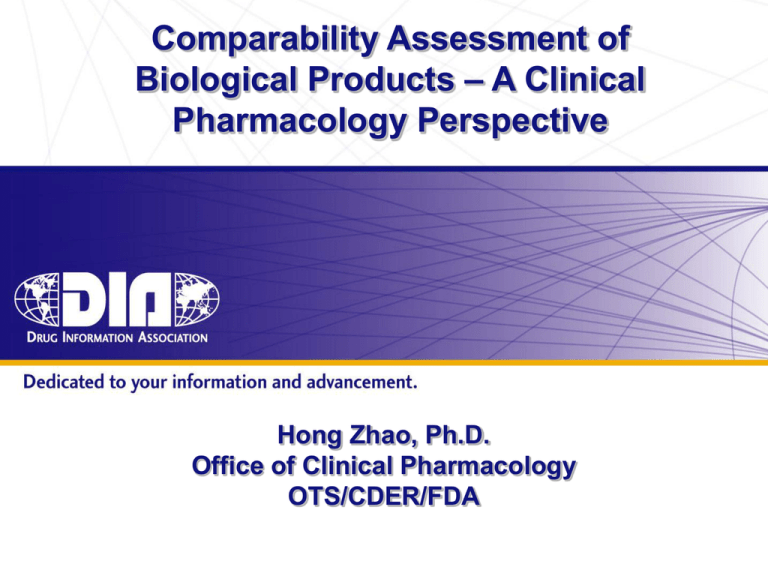
Comparability Assessment of
Biological Products – A Clinical
Pharmacology Perspective
Hong Zhao, Ph.D.
Office of Clinical Pharmacology
OTS/CDER/FDA
www.diahome.org
Disclaimer
The views and opinions expressed in the following PowerPoint slides are
those of the individual presenter and should not be attributed to Drug
Information Association, Inc. (“DIA”), its directors, officers, employees,
volunteers, members, chapters, councils, Special Interest Area
Communities or affiliates, or any organization with which the presenter is
employed or affiliated.
These PowerPoint slides are the intellectual property of the individual
presenter and are protected under the copyright laws of the United
States of America and other countries. Used by permission. All rights
reserved. Drug Information Association, DIA and DIA logo are registered
trademarks or trademarks of Drug Information Association Inc. All other
trademarks are the property of their respective owners.
www.diahome.org
Outline
Biological Product Comparability Program
• Why are PK and PD studies necessary?
• What is the role of PK & PD studies?
• When should PK & PD studies be conducted?
• How are PK & PD studies conducted?
• How is the PK & PD comparability assessed?
• What are the challenges?
Summary and Comments
www.diahome.org
Biological Product Comparability
Manufacturing process changes to improve
product quality, yield and manufacturing
efficiency
• during product development
• post approval
Comparability: highly similar quality attributes,
no adverse impact on the efficacy and safety,
including immunogenicity
www.diahome.org
Comparability Program
Mainly
Occasionally
Sometimes
Identity
Activity
PK
Efficacy
Strength
Toxicity
PD
Safety
Quality
e.g.,
Purity
NTR agents
Toxic Impurities
Adventitious agents
Potency
Immunogenicity
www.diahome.org
Rarely
e.g.,
Efalizumab
Why are PK and PD studies necessary?
Major changes
can impact
Minor changes
may affect
Quality attributes
not well understood
Clinical performance
Analytical Technology
Prediction of
Knowledge
Clinical performance
Experience
PK and PD studies are considered complementary to CMC testing
to reduce the need for clinical studies
www.diahome.org
Why PD?
• Limitations with PK studies (PK assays)
• Potency assays reflecting multiple mechanisms
of action (MOA) may not be available, eg.
Relevant bioassays for TNF antagonists
– Prevention of joint inflammation in animal models
– Blocking TNF mediated inhibition of cell proliferation
– Blocking tyrosine phosphorylation of downstream signaling
components
• PD may provide information on product activity
• Support PK to further reduce uncertainty
www.diahome.org
What is the role of PK & PD studies?
Preclinical
Clinical Development
Phase 1
Phase 2
Phase 3
Post
Approval
Manufacturing changes occur
to bridge animal pharmacology and toxicology
data to humans and
to determine the relevance of the data obtained in
Phase 1 PK & PD characterization to Phase 2
dose ranging and proof-of-concept studies
www.diahome.org
What is the role of PK & PD studies?
Preclinical
Clinical Development
Phase 1
Phase 2
Phase 3
Post
Approval
Manufacturing changes occur
to determine the need to change the dose(s)
selected in Phase 2 for Phase 3 studies due to
manufacturing changes
to determine the need for repeating the PK and
PD characterization studies in humans
www.diahome.org
What is the role of PK & PD studies?
Preclinical
Clinical Development
Phase 1
Phase 2
Phase 3
Post
Approval
Manufacturing changes occur
to establish PK & PD comparability between the to-bemarketed (TBM) product and the product tested in Phase 3
trials
This is a critical stage and the assessment of comparability
is more rigorous
Differences in PK & PD between the products may
translate to differences in efficacy and safety
www.diahome.org
When should PK & PD studies be conducted?
Determined by
Types and magnitude of changes
Stage of product development
Therapeutic window
Ability to link the altered product
characteristics with product activity
www.diahome.org
When should PK & PD studies be conducted?
Potentially for the following situations:
Upstream process changes (such as change of cell lines or
fermentation process, modifying glycosylation pattern and/or sialic acid
content)
Changes to the product formulation
Appearance of new product- or process-related
impurity (raising immunogenicity concern)
Changes to a product characteristics
Changes for novel products with unique
structure, function or mechanism of action
www.diahome.org
How are PK & PD studies conducted?
Study Population
Population
Advantages
Limitations
Animals
Easy access, shorter study time
and lower cost, often used in
early stage studies
Lack of relevance to
humans,
immunogenicity,
small sample size
Healthy
Volunteers
Homogeneous, less variability,
often used in late stage studies
Not suitable for
cytotoxic agents, CNS
compounds,
immunomodulators,
products with diseasespecific or targetmediated disposition
Patients
Indicated population, most relevant,
often used in late stage studies
Heterogeneity in nature,
larger variability,
feasibility
www.diahome.org
How are PK & PD studies conducted?
Study Design
Cross-over
• Pros: requires smaller sample size
• Cons: not suitable for products with long t1/2, carryover effects including immunogenicity
Parallel
• Pros: suitable for products with long t1/2 (mAbs)
• Cons: requires larger sample size
Sequential
• Pros: used in clinical setting, dosing interval > 5 t1/2
Cons: carry-over effects including immunogenicity
www.diahome.org
How are PK & PD studies conducted?
Sample Size
• Many PK&PD comparability studies are conducted with
small sample size, especially in NHP and patients
• Failed to show comparability due to inadequate power
(primary reason) or study design and/or study conduct
• Results from an underpowered study are inconclusive
regarding product comparability
• PK&PD studies should enroll adequate # of subjects to
generate definitive conclusion on comparability, especially
in the evaluation of post phase 3 or post-marketing
manufacturing changes
www.diahome.org
How are PK & PD comparability assessed?
• Bioequivalence (BE) criteria
– PK parameters (AUC0-t, AUC, Cmax)
– 2-sided 90% Confidence Intervals for the geometric mean
ratios to be within [80%, 125%]
• Other appropriate statistical analysis methods for
evaluation of PD parameters
• Acceptance of any deviations depends on the stage of
product development, the role of the comparability study
and the implication of the results
• It is crucial to demonstrate PK & PD comparability between
the to-be-marketed product and the clinical trial product
www.diahome.org
Summary
• Major components in comparability program, and their
roles in the comparability assessment
• PK & PD comparability studies - why, what, when & how
• Acceptance of PK & PD comparability results depends on
the stage of product development, the role of the study and
the implication of the results
• Additional clinical trials may become necessary when
PK&PD studies failed to demonstrate the comparability
between the TBM product and the clinical trial product
www.diahome.org
What are the challenges?
Identify critical product quality attributes
Understand the relationships between these
critical quality attributes and clinical performance
Establish a risk assessment system
PK & PD comparability evaluation:
– Products with a long half-life
– Products with a large variability
– Influence of immunogenicity
– Limited sample size
(especially for NHPs, patients)
www.diahome.org
Comments
• Make major manufacturing changes at early stage
• Include the to-be-marketed product in the clinical
trials
• Design critical PK & PD comparability studies
with sufficient power
• Need to consider both PK and PD and look at the
data in totality
• Consider relevance to clinical efficacy and safety
www.diahome.org
www.diahome.org






